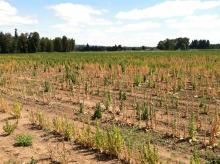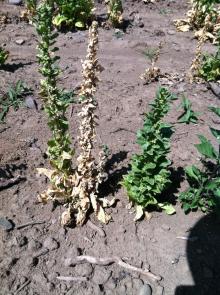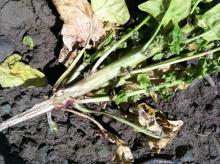By L.J. du Toit and C.M. Ocamb
Cause Fusarium oxysporum f. sp. spinaciae, a fungus that can survive many years in soil without a spinach crop. The fungus also can colonize roots of beet and Swiss chard plants, but does not cause disease on these crops. The fungus can survive on seed and cause disease in fields previously free of spinach wilt. Warm, acidic soils favor the pathogen.
Symptoms Two types are observed commonly in seed crops: a seedling disease, which can be confused with damping-off; and premature dying of older plants.
In the seedling stage, plants appear normal until the first true leaves form. Then cotyledon leaves wilt and in 7 to 10 days the plant dies. Roots may have a black lesion at the base, and vascular tissue will be dark or discolored; few feeder roots develop. Plants may die any time from seedling stage to seed-crop maturity.
Symptoms on older plants include general yellowing of lower leaves, early maturity, premature death, and reduced seed production; in some instances, the plant dies before developing seed. Older plants may have darkened vascular tissue and extensive secondary-root development. The stem base is discolored, and fungal mycelium may be seen. In general, older diseased plants appear to be suffering from extreme drought and/or severe root rot.
Cultural control
- Avoid planting on soil known to be infested with Fusarium wilt of spinach.
- Do not plant spinach in consecutive years. A 4- to 6-year rotation may help control wilt, although 6- to 12-year rotations may be necessary for spinach seed crops with susceptible parent (inbred) lines on acid soils.
- Planting early may reduce seedling disease because of lower soil temperature during initial plant development.
- The smooth-leaf varieties, St. Helens and Jade and semisavoy types 'Chinook II' and 'Skookum' are either resistant or tolerant to Fusarium wilt.
- If not growing the crop for seed, do not let plants flower and go to seed.
- Amendment of acid soils (pH < 6.5) with limestone (at least 1 or 2 tons agricultural limestone/acre) can suppress Fusarium wilt in spinach seed crops.
- If possible, minimize moisture stress to spinach seed crops during flowering and seed set.
Chemical control
- Use seed treatment.
- Mertect 340-F (Group 1) at 0.006 mg ai/seed plus a dye. To control pathogenic Fusarium spp.
- Band at planting
- Proline 480 SC (Group 3) at 5.7 fl oz/A for disease suppression. For seed crops only in Oregon (SLN OR-150016) and Washington (SLN WA-160004) only. No more than three (3) applications per year with a minimum 21-day interval between applications. WSU reported higher, but nonsignificant, marketable seed yields with three Proline applications. Although putative incidence of Fusarium wilt, as indicated by vascular discoloration, was not reduced, Proline did reduce wilt severity as measured by percentage of individual plants' foliage with wilting. Preharvest interval is 14 days. 12-hr reentry.
Biological control
- Actinovate AG at 3 to 12 oz/A as a soil drench at planting. 4-hr reentry. O
- Actinovate Lawn & Garden at 0.5 to 1 teaspoon/gal water. H O
- Bexfond at 7 to 14 fl oz/A for soil applications via drenches, in-furrow applications, drip irrigation, or sprays followed by irrigation. Reapply 3 to 4 weeks after planting. 4-hr reentry. O
- Mycostop at 0.07 oz/lb seed. 4-hr reentry. O
- Rootshield WP at 3 to 8 oz/100 gal water for greenhouse soil drench and field chemigation or at 16 to 32 oz/A as an in-furrow spray. 4-hr reentry. O
References du Toit, L.J., Derie, M.L., Brissey, L.M., and Cummings, J.A. 2007. Evaluation of limestone amendments for control of fusarium wilt in a spinach seed crop, 2006. Plant Disease Management Reports 1:V091.
Gatch, E.W. Derie, M.L., Holmes, B.J., and du Toit, L.J. 2013. Effect of Proline 480 SC on Fusarium wilt in a spinach seed crop in western Washington, 2012. Plant Disease Management Reports 10:V103.




